- This topic has 36 replies, 21 voices, and was last updated 9 years, 7 months ago by
 Robin Leadbeater.
Robin Leadbeater.
-
AuthorPosts
-
9 May 2016 at 6:08 am #573566
 Nick JamesParticipant
Nick JamesParticipantBest of luck today with the transit. The weather prospects for the UK look better the further north and east you go. Dominic’s article here gives an excellent overview of the event. If you want very precise timings for the contacts Xavier Jubier’s Mercury Transit Calculator is the place to go.
Remember that Mercury will be very small. To give some scale it will be around a third the area of the current largest spot group (AR2542).
Post pictures here if you get anything.
Nick.
9 May 2016 at 12:26 pm #577348 Jeremy ShearsParticipant
Jeremy ShearsParticipantJust watched the start of the transit under reasonable conditions here in Cheshire.
Jeremy
9 May 2016 at 12:42 pm #577349 Howard DaviesParticipant
Howard DaviesParticipantCloudy here in Swansea,the web live streaming sites seem to me busy.
9 May 2016 at 1:11 pm #577350 Nick JamesParticipant
Nick JamesParticipantAfter a lovely clear morning cloud came across just as Mercury moved onto the disk. Here’s some video I shot but the seeing is awful and the clouds were a real pain. This is a single frame from the video near the time of internal contact.
 9 May 2016 at 1:33 pm #577352
9 May 2016 at 1:33 pm #577352 Nick JamesParticipant
Nick JamesParticipantI wonder what people would have thought back in 2003 when we had the last transit of Mercury if you had told them that in 2016 we’d be taking pictures like this with a mobile phone!
9 May 2016 at 1:52 pm #577353 Denis BuczynskiParticipant
Denis BuczynskiParticipant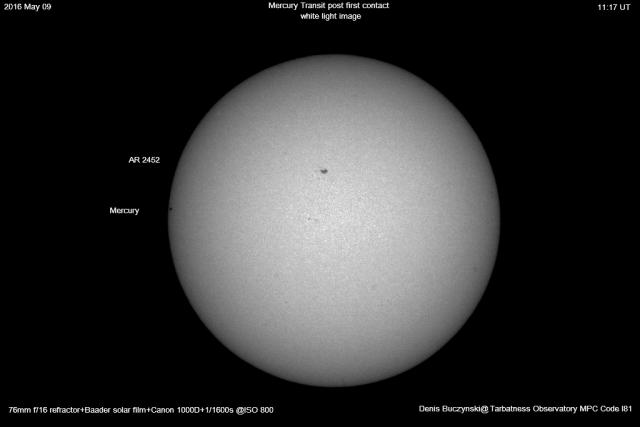 Hello all, Attached is an image I took of the transit just after first contact. Conditions here at Tarbatness are clear with a cold easterly wind , temperature 10d C. Seeing was fair. Mecury looks a very inky black dot in the Ha view, some small prominences also on view.9 May 2016 at 2:32 pm #577355
Hello all, Attached is an image I took of the transit just after first contact. Conditions here at Tarbatness are clear with a cold easterly wind , temperature 10d C. Seeing was fair. Mecury looks a very inky black dot in the Ha view, some small prominences also on view.9 May 2016 at 2:32 pm #577355 Martin MobberleyParticipant
Martin MobberleyParticipantClear for the first hour here in Suffolk, but cloudy now. Managed to get a few videos with the Lunt FS60 H-alpha scope, so plenty of processing to do. Seeing was appallingly bad, even for Suffolk!! A single frame just after second contact is, hopefully, attached to this post…… 3xBarlow + Skynyx 2-0. 1/20th sec.
Martin
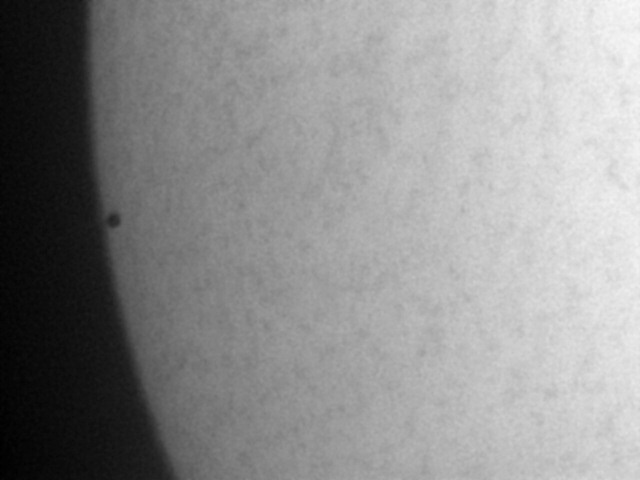 9 May 2016 at 2:36 pm #577351
9 May 2016 at 2:36 pm #577351 Gary PoynerParticipant
Gary PoynerParticipantMajority of cloud cleared here 10 mins before start. Managed this photo – hand held mobile phone with 14mm Radian eyepiece on 22cm dobby stopped to 10cm using ancient solar screen. Time 11.41UT
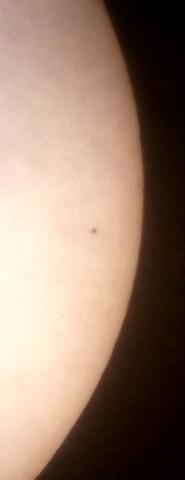
Gary
9 May 2016 at 2:53 pm #577356 Nick JamesParticipant
Nick JamesParticipantIt’s cleared up a bit now. This image was taken a few minutes ago.
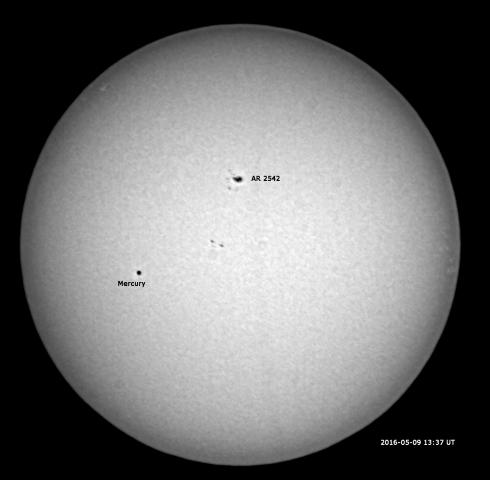 9 May 2016 at 3:00 pm #577354
9 May 2016 at 3:00 pm #577354 Jeremy ShearsParticipant
Jeremy ShearsParticipantInspired by Gary’s image, I tried with my iPhone at 13.35 UT (sunspot just above centre, Mercury below). I held it to the 18 mm eyepiece of my Takahashi FS 102 (102 mm refractor, f/8) with Thousand Oaks solar filter.
Jeremy
9 May 2016 at 4:11 pm #577357 DawsonParticipant
DawsonParticipantI’m working on a time lapse, but cloud and wind are working against me 🙂 Here is a link to a very rough and ready and low res time lapse of the first three hours of the transit:
https://dl.dropboxusercontent.com/u/1673286/Mercury%20transit%20the%20first%20three%20hours.avi
Skywatcher ED80, Baader solar film, Tal 2x Barlow, Canon 6D; one shot every 60 seconds for the first three hours, stacked into an AVI (on a loop) in PIPP.
James
P.S. I should add there are numerous dust bunnies which also look like they are trying to transit the sun 🙂 I’m not sure yet how to process these out as I can’t think how to take flats with solar film!
9 May 2016 at 4:30 pm #577358 Nick JamesParticipant
Nick JamesParticipantThat’s a really nice timelapse James. I’m doing the Sky Notes at the next BAA London meeting and would like to show the final version when you have it. I hope you get clear weather through to the end.
9 May 2016 at 5:13 pm #577359 Martin MobberleyParticipant
Martin MobberleyParticipantSky quality since 1pm BST has been dire, but I’ve uploaded an image sequence taken in the first half hour here:
http://martinmobberley.co.uk/images/Transit_of_Mercury_20160509_mpm.jpg
Martin
9 May 2016 at 5:24 pm #577360 Denis BuczynskiParticipant
Denis BuczynskiParticipantHello all, Attached is an Ha image of the transit just after mid transit.
Apologies the AR numbers should be 25 etc not 24 etc
Denis Buczynski Tarbatness
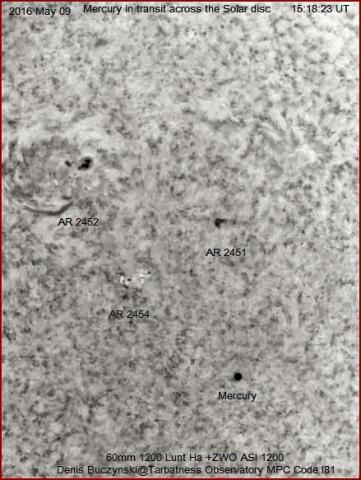 9 May 2016 at 5:38 pm #577361
9 May 2016 at 5:38 pm #577361 Stewart MooreParticipant
Stewart MooreParticipantAfter days of wall to wall sunshine the cloud today was, i suppose, predictable. Sky clear for ingress with a few bits of high cirrus but raher more expanded con-trails. Observing visually using 300mm f/5.3 Newt changed to f/14.5 by reduced aperture home made Bader filter. Seeing very poor (Thorpe-le-Soken, Essex). Even though knowing where Mercury would appear the limb distinction was so poor I could not be sure I was seeing Mercury until 11:15UT when it was on the disk (I had intended to time first contact). By 11:30UT it was well on the Sun as a jet black disk looking really beautiful. After about 45 minutes I got bored… so had lunch. It was not visible in Bader filtered 10×50 bins.
By 14:00UT the seeing had improved slightly but there was more haze around. Sky finally clouded around 15:00UT so stopped observing and did a major spider/ cobweb clearance from the observatory – the first time it had been opened for many months following knee problems.
9 May 2016 at 8:39 pm #577362 Peter CarsonParticipant
Peter CarsonParticipant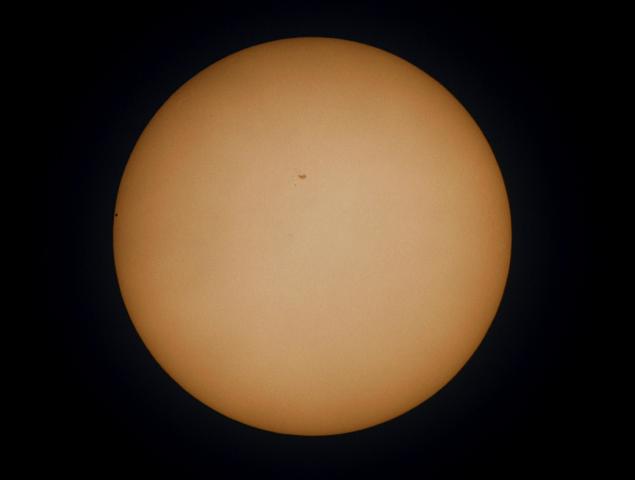 Had a great day. About 19 members of my local astro club descended on my garden with Ha, calcium K and white light scopes. The wine, beer and cheese and biscuits are now all consumed and I’ve just started looking at my images. I’d left my DSLR automatically taking pictures through my 100 mm refractor in my observatory. Most of the pictures are of cloud or the inside of my observatory dome but some came out OK.
Had a great day. About 19 members of my local astro club descended on my garden with Ha, calcium K and white light scopes. The wine, beer and cheese and biscuits are now all consumed and I’ve just started looking at my images. I’d left my DSLR automatically taking pictures through my 100 mm refractor in my observatory. Most of the pictures are of cloud or the inside of my observatory dome but some came out OK. Peter
10 May 2016 at 6:31 am #577363 Paul Anthony BrierleyParticipant
Paul Anthony BrierleyParticipantWhen I saw the transit. It was between 1305 and 1325 hrs. I was looking through haze, but I was able to see Mercury, as a small black “ink spot”
Looking at the planet, against the massive Sun. It made me realise, just how massive our G class yellow star is. And how tiny the planet was. Conditions were far from ideal with high cirrus and wind. But I saw it.
Equipment used.
Williams Optics Zenith Star 66sd, with baader white light filter, and a Vixen Lv Zoom ep. This was set at 16mm giving x24 magnification.
10 May 2016 at 9:11 am #577364 Bill WardParticipant
Bill WardParticipantHi,
Wall to wall sunshine and 24C, I could hardly believe it!
Here are a couple of images I took in the evening.
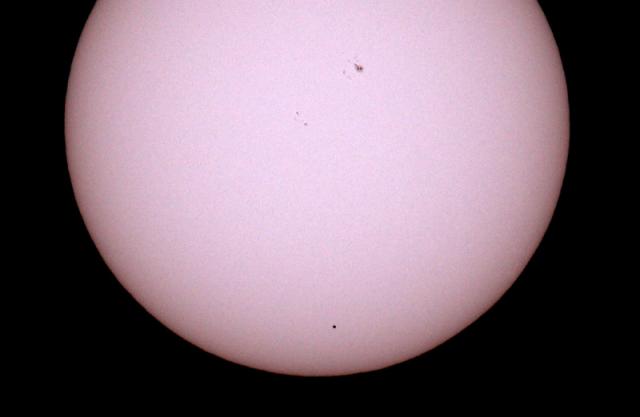
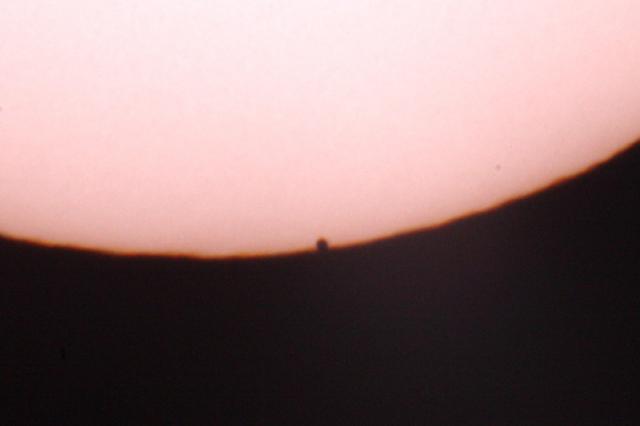
after so many washouts over the years nice to finally see one end to end.
cheers,
Bill.
10 May 2016 at 11:45 am #577366 Tim ParsonsParticipant
Tim ParsonsParticipantQuite a bit of low cloud and strong winds in Haslemere (South West Surrey), but there were decent breaks in the cloud during the first couple of hours of the transit to reward patient observation.
I was interested in Stewart’s comment that nothing was visible in 10×50 bins with the poor seeing at Thorpe-le-Soken. I used Lunt 11×70 bins with Orion solar filters and in the intermittent moments of good seeing, Mercury was very distinctly visible as was the sunspot group AR2542. Both were easy to pick out. The smaller sunspots near to 2542 and those near the solar equator were only very briefly visible in a single very steady moment of seeing (and, yes, I saw those before checking photos of the solar disk!). With only the binoculars and lots of cloud, first and second contact were not observed, I could only pick up Mercury once fully on the solar disk at 1116UT.
I had the Lunts mounted on the rather nifty Orion Paragon parallelogram mount which made for a comfortable and steady set up notwithstanding the tendency for it to act like a weather vane in the prevailing winds!
Thanks from me as well to all those who have posted some great pictures.
Cheers,
Tim
10 May 2016 at 1:33 pm #577367 Mick CrookParticipant
Mick CrookParticipant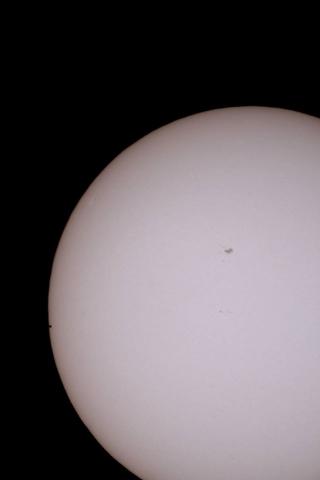
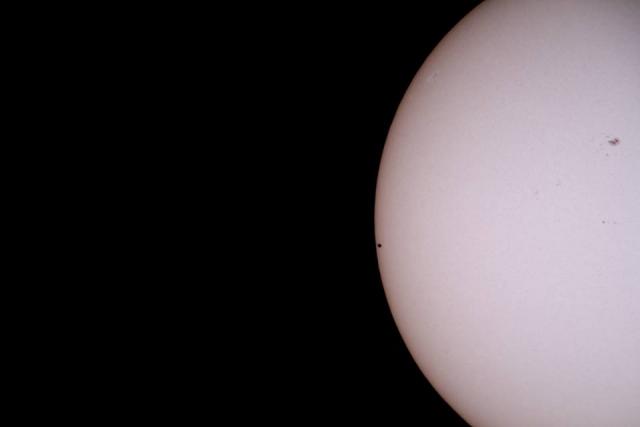
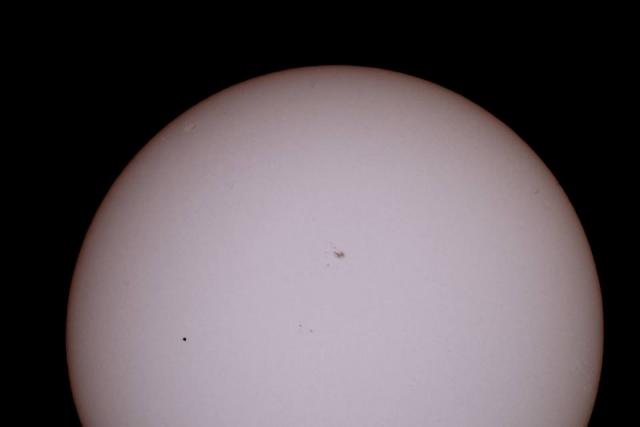 3 Images taken with Orion 140 Maksutov f14.3, Baader Solar Film and Canon 1000D DSLR from Fulwood Preston.
3 Images taken with Orion 140 Maksutov f14.3, Baader Solar Film and Canon 1000D DSLR from Fulwood Preston.Excellent conditions with hardly a cloud in the sky (rare for Lancashire!) I missed the end of the transit as the Sun had dipped behind the trees.
2nd Contact – 11:15 UT, just after 2nd Contact 11:17 UT and one at 13:11 UT
-
AuthorPosts
- You must be logged in to reply to this topic.
